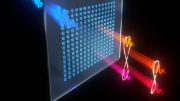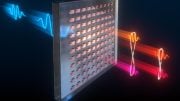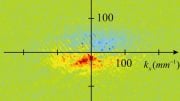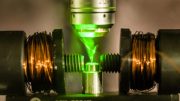
Physicists have pioneered a method to engineer electromagnetic spin on metasurfaces, addressing the data storage and transfer needs of an increasingly digital world. This innovation could lead to future data systems using binary photon spin for efficient encoding and manipulation of information.
The concept of a refrigerator that automatically handles your grocery shopping and alerts you to expired food may seem like an exhilarating glimpse into the not-so-distant future. However, the less glamorous side of the Internet of Things (IoT) lies in the enormous volumes of data it will generate, necessitating its storage and transmission between different points. Each cloud server, no matter how remote, physically exists somewhere and data must travel from that location to other areas, even within the server itself. This data transfer can potentially turn into a major hurdle for the efficiency of data processing.
Similarily, artificial intelligence is increasingly becoming an everyday feature, yet it also demands heavy data transfer. Technologies such as blockchain, increased media consumption, and virtual reality will all add to the rising tide of error messages and notifications urging us to boost our storage capacity and data communication bandwidth.
Spintronics is a field that explores the spin properties of electrons and it has the potential to revolutionize data storage and transfer by offering new types of memory devices that can store data more efficiently. Similarly, photonics can offer greater capacity than traditional technologies to encode information on light photons using their polarization, akin spin for electrons, but only if you can control it.
In research published in Nature Nanotechnology, physicists from TMOS, the ARC Centre of Excellence for Transformative Meta-Optical Systems, including Associate Investigators from the City University of New York, the Australian National University, and the Airforce Research Laboratory, have developed a new method for designing metasurfaces. This method can engineer electromagnetic spin by generating a new type of photonic mode in an innovative Dirac-like waveguide. This advances previous research into low-loss information transfer that uses signal transmission along topological interfaces.
Traditionally, topological waveguides are built with abrupt edges between their various interfaces. These edges create boundary modes—electromagnetic waves that behave differently where edges exist than they do across the bulk of the material. These boundary modes can be used productively in many ways, but they have only one spin direction and lack radiation control.
Lead investigator Prof. Alexander B. Khanikaev and his team have taken a new approach to metasurface interfaces. Instead of a hard edge, they have smoothed the boundaries by patterning a gradual shift into the metasurface slab. Rather than discrete shapes butted up together, they’ve made small variations to the design, in this case, a pattern of holes that form repeating hexagons, so the shapes gradually join. This has generated brand-new modes of electromagnetic wave never seen before in a metasurface, with radiative properties that are very exciting. At a single frequency, two modes of different spin could co-exist, one radiating more than the other. By hitting the metasurface with a circularly polarized laser, Kiriushechkina et al. were able to pick up a specific mode spin. This was proven in the laboratory by each mode propagating at different lengths when excited.
This method could soon lead to an ability to independently control the spin of both modes. This would create a binary degree of freedom, which opens up significant opportunities for the field of spin-photonics and the eventual development of data storage systems that use binary photon spin to encode and manipulate information.
Co-first author Dr Daria Smirnova says “The proof-of-concept experiment conclusively validated our theoretical findings and modeling. Curiously enough, the effect can be explained by merging the Dirac formalism with handy electrodynamics to describe the radiative nature of the modes designed.”
Khanikaev says, “The possibility to engineer a binary spin-like structure of light on a chip and the possibility to manipulate it on demand opens truly exciting opportunities to encode information in it, especially quantum information. Our team, in collaboration with our colleagues from TMOS and AFRL, is currently working on creating quantum interconnects based on such photonic spin, but also on elementary quantum logic operations on a silicon photonic chip. As such, we believe that, in the long run, integrated Dirac photonic systems can become a viable platform for integrated quantum photonics.”
TMOS Centre Director Dragomir Neshev says, “This cross-institution teamwork has advanced the field of meta-optics significantly. It is an extraordinary achievement and a prime example of why Centres of Excellence exist. They facilitate the sharing of knowledge and expertise in a way that is often limited by a researcher’s own networks. I’m excited to see what comes next from these collaborators.”
Reference: “Spin-dependent properties of optical modes guided by adiabatic trapping potentials in photonic Dirac metasurfaces” by Svetlana Kiriushechkina, Anton Vakulenko, Daria Smirnova, Sriram Guddala, Yuma Kawaguchi, Filipp Komissarenko, Monica Allen, Jeffery Allen and Alexander B. Khanikaev, 27 April 2023, Nature Nanotechnology.
DOI: 10.1038/s41565-023-01380-9









Be the first to comment on "Spinning Into the Future – New Waveguide Is Changing the Way Data Is Transferred and Manipulated"